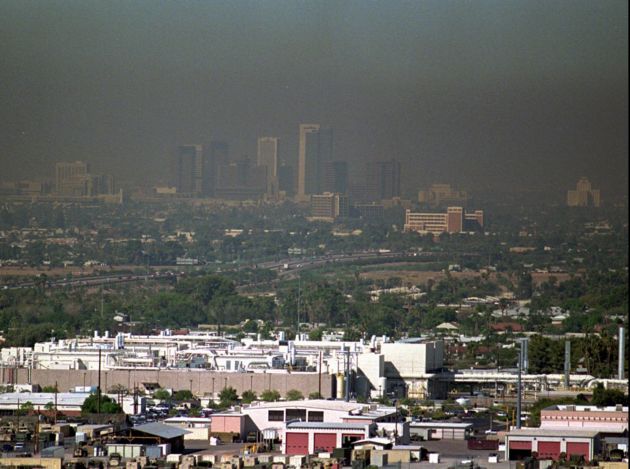Charge: Carbon Dioxide Hogs Global Warming Stage

Carbon dioxide hogs the spotlight on the stage of chemical culprits causing global warming, but other greenhouse gases deserve some blame, scientists say.
“People need to be aware that it isn’t just CO2 that’s the problem,” said Keith Shine of the University of Reading in England, co-author of an article in the March 30 issue of the journal Science discussing the many unknowns about the complex mixture of greenhouse gases emitted into Earth’s atmosphere.
All the gases contributing to the greenhouse effect—a blanket of sorts that lets sunlight in but then traps the heat that it generates—should be studied more thoroughly for scientists to understand climate change fully, he said.
The pieces of the puzzle
Greenhouse gases absorb the infrared radiation coming from the planet’s surface and re-emit it back to Earth, increasing the globe’s average temperature. Carbon dioxide accounts for the bulk of this warming because so much of it has been released into the atmosphere in the last century.
“CO2 is the most important greenhouse gas—there’s no question about that,” Shine said.
While other greenhouse gases make up less of the atmosphere, they account for about 40 percent of the greenhouse gas radiation sent back to Earth. They can also be much more efficient at absorbing and re-emitting radiation than carbon dioxide, so they are small but important elements in the equation.
Sign up for the Live Science daily newsletter now
Get the world’s most fascinating discoveries delivered straight to your inbox.
In fact, molecule-for-molecule some gases containing lots of fluorine are 10,000 times stronger at absorbing radiation than carbon dioxide.
“Greenhouse gases come in different strengths,” Shine said.
But just what the role of many of these other gases is in terms of global warming has presented scientists with a tricky puzzle.
Mysterious methane
While carbon dioxide comes primarily from the burning of fossil fuels, methane—another greenhouse gas—can come from landfills, animal waste, the melting of permafrost and fossil fuel burning. Scientists are still debating what all of the natural sources of the gas are and how much methane is naturally found in the atmosphere.
“There’s a wide variety of sources from which it comes,” Shine said.
Scientists also don’t know exactly what methane does once it’s emitted into the atmosphere because it is very short-lived and reactive with other molecules.
The methane piece of the global warming puzzle is even more difficult to grasp because while its levels have steadily risen since the mid-19th century, they have leveled off in the past decade, and scientists aren’t sure why—there could be less methane emissions or more destruction of the molecule as it reacts in the atmosphere.
Another big question scientists have about this trend, Shine said, is: “Is this a temporary blip or has it leveled off permanently?” That question is hard to answer since they don’t know the reasons behind the slow-down.
Super-greenhouse gases
Other greenhouse gases make up an even smaller portion of the total greenhouse gases in the atmosphere, but are more long-lived and less reactive than methane.
Chlorofluorocarbons, banned by an international agreement known as the Montreal Protocol because they eat up atmospheric ozone, are also greenhouse gases. While levels of this gas, formerly used in air conditioners and refrigerators, are no longer rising, the gas won’t completely leave the atmosphere for many decades.
“We just have to wait for the atmosphere to cleanse itself,” Shine said.
Other heavily fluorinated gases are very long-lived, almost permanent, in the atmosphere and are still being emitted. And their contributions to global warming still aren’t completely known.
Mitigation
According to the Kyoto Protocol, which the United States did not ratify, countries were told to reduce their overall emissions, which they can achieve by controlling carbon dioxide, methane or any of the other greenhouse gases.
“It’s an overall basket approach,” Shine said.
But all of these missing pieces in the global warming puzzle make finding viable solutions to enforce the mandate of the Kyoto Protocol all the more difficult.
“If we don’t know what they’re doing,” Shine said, “then we can’t respond to them.”
More to Explore
- 10 Surprising Results of Global Warming
- Emerging Environmental Technologies
- Video: Goldilocks and the Greenhouse
- How You Can Fight Global Warming
Global Warming Features
- Earth Will Survive Global Warming, But Will We?
- Strange Weather's Loose Link to Global Warming
- Global Warming or Just Hot Air? A Dozen Different Views
Recent Climate Change News
- Sun Blamed for Warming of Earth and Other Worlds
- Protecting Ozone Layer Also Slowed Global Warming
- Surprising New Arctic Inhabitants: Trees
- Earth's Polar Regions Target of Year-Long Study
Hot Topic

What makes Earth habitable? This LiveScience original video explores the science of global warming and explains how, for now, conditions here are just right.
The Controversy
- Sun Blamed for Warming of Earth and Other Worlds
- World's Largest Science Group Chimes in on Climate Change
- 113 Nations Agree ... Climate Change 'Very Likely' Caused by Humans
- White House Accused of Misleading Public on Global Warming
- Global Warming or Just Hot Air? A Dozen Different Views
- Report: Global Warming's Smoking Gun is on the Table
- Global Warming Differences Resolved
- Baffled Scientists Say Less Sunlight Reaching Earth
- Scientists Clueless over Sun's Effect on Earth
- Greenhouse Gas Hits Record High
- Key Argument for Global Warming Critics Evaporates
The Effects
- Seas Rise
- More Wildfires
- Deserts to Grow
- Greenland Melts
- Mountains Grow
- Ground Collapses
- Glaciers Disappear
- Allergies Get Worse
- Summer Gets Longer
- Animal DNA Changing
- Animals Change Behavior
- Rivers Melt Sooner in Spring
- Increased Plant Production
- Hurricanes Get Stronger
- Some Trees Benefit
- Lakes Disappear
The Possibilities
- More Rain but Less Water
- Ice-Free Arctic Summers
- Overwhelmed Storm Drains
- Worst Mass Extinction Ever
- A Chilled Planet
Strange Solutions

Andrea Thompson is an associate editor at Scientific American, where she covers sustainability, energy and the environment. Prior to that, she was a senior writer covering climate science at Climate Central and a reporter and editor at Live Science, where she primarily covered Earth science and the environment. She holds a graduate degree in science health and environmental reporting from New York University, as well as a bachelor of science and and masters of science in atmospheric chemistry from the Georgia Institute of Technology.










